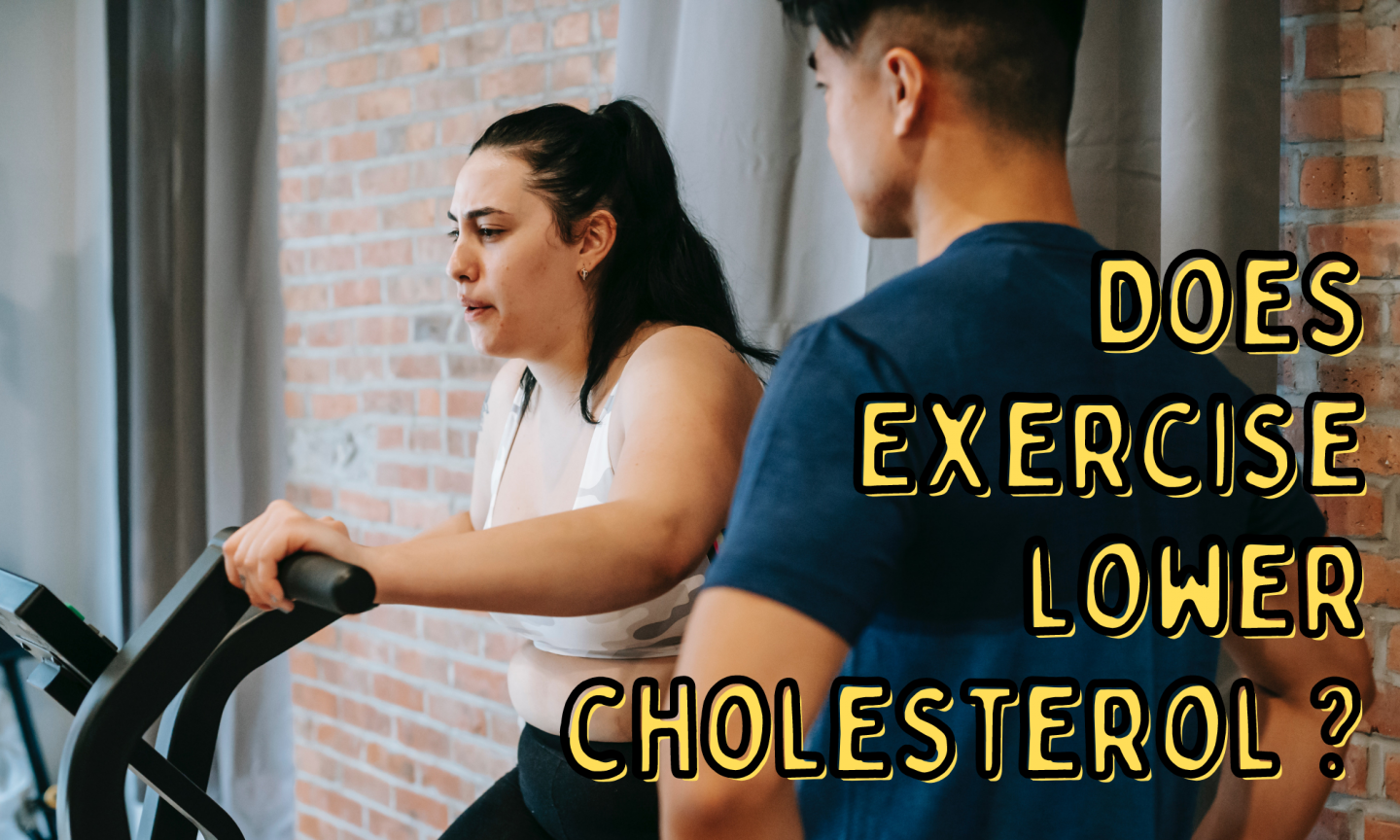Does Exercise Lower Cholesterol?
20th Jul 2022
Chris Nicklin is a certified Personal Trainer with over 7 years' experience, and the owner of Nxtep Personal Training. Chris qualified from Edge Hill University with a Bachelor of Science (BSc) degree in Sports Coaching and Performance Development, and has delivered over ten thousand one-to-one Personal Training sessions.
What is cholesterol?
Cholesterol is a type of lipoprotein that is found in the bloodstream and is responsible for helping to build up the walls of our arteries. It is constructed of fat and proteins, and is made in the liver. Your body needs cholesterol to make hormones (including testosterone and estrogen), cell membranes, and other important substances.
What are the different types of cholesterol?
There are three main types of cholesterol: HDL, LDL, and VLDL.
What Is LDL?
LDL (low-density lipoprotein) is the most common type of cholesterol. It’s often called “bad cholesterol.” LDL is made up of small, dense particles that can travel through the bloodstream and collect on the surfaces of arteries. High levels of LDL cholesterol can eventually damage the artery walls, and cause a number of health issues such as high blood pressure.
What is VLDL cholesterol?
VLDL cholesterol (very low-density lipoprotein) is a type of cholesterol that is transported in the blood. VLDL cholesterol is created when triglycerides are broken down in the liver. VLDL is made up of large, fluffy particles that can’t travel through the bloodstream as easily as LDL or HDL. This can lead to the accumulation of cholesterol on the walls of your arteries, and eventually to coronary heart disease and stroke. Even moderate exercise can help to lower VLDL cholesterol levels by increasing your HDL (good) cholesterol and reducing your LDL (bad) cholesterol.
What Is HDL?
HDL (high-density lipoprotein) is the “good” cholesterol. HDL carries cholesterol away from your arteries and helps to protect your heart. HDL also helps to remove bad cholesterol from the blood. Exercise can help to increase your HDL levels by increasing your heart rate and muscle mass.
What are the risks with a high cholesterol level?

There are many risks associated with having a high cholesterol level. Some of the most serious risks include: cardiovascular disease, stroke, memory loss, and liver damage.
Cardiovascular disease is the leading cause of death for males in the UK. A high cholesterol level can increase your risk of developing coronary heart disease by raising your levels of bad cholesterol (LDL) and decreasing your levels of good cholesterol (HDL).
A high cholesterol level can also lead to stroke, which is a serious medical condition that occurs when blood supply to part or all of the brain is blocked (which can be caused by the build-up of cholesterol on the artery walls). Stroke can cause permanent damage to your brain and can be fatal.
A high cholesterol level also increases your risk of developing memory loss and dementia, which is the leading cause of death for females. Memory loss is a common problem in older adults and can be due to a number of factors, including age, injury, illness, and dementia. Dementia refers to a broad range of conditions that affect intelligence or ability to think clearly.
How is cholesterol measured?
To find out how much cholesterol a person has, a blood lipids test known as a “lipid profile” must be performed on them. Total cholesterol, HDL cholesterol, and LDL cholesterol are all included in this test, as are triglycerides, a different form of blood fat. To take a test, most people fast (don’t eat) and consume just water for around 10 hours beforehand.
A simple blood test is all that is required for a cholesterol test. There are 2 ways this can be done:
- A fast and painless finger prick test allows you to see the findings right away.
- A little amount of blood is drawn from your arm and sent off for analysis using a needle and syringe.
Understanding Your Results
Total cholesterol
TC stands for total cholesterol, which may be abbreviated to ‘serum cholesterol’ or just ‘TC.’ It measures your total blood cholesterol levels.
HDL cholesterol
In order to keep your arteries free of cholesterol, your HDL cholesterol (also known as “good” cholesterol) works as a cleanser. The optimal HDL cholesterol level is 1.4mmol/L, however experts feel that greater levels may not provide any further advantage.
Non HDL cholesterol
Non-HDL cholesterol is calculated by subtracting HDL cholesterol from total cholesterol. It consists of all of your “bad” cholesterol, including LDL and VLDL cholesterol. It should be as low as possible.
TC:HDL ratio
You might be given a TC:HDL ratio, which shows how much HDL you have compared to how much total cholesterol you have. If not, you can figure it out by adding up your HDL cholesterol and your total cholesterol. Ideally this number should be as low as possible.
What is a good cholesterol level?
The NHS recommends that LDL cholesterol should be below 3 mmol/L, while HDL should be over 1 mmol/L for men and over 1.2 – 1.4 for women.
I’ve put together the table below which shows you the recommended levels for each type of cholesterol:
| Metric | mg/dL | mmol/L |
| Total cholesterol (TC) | under 193 | under 5.0 |
| Non-HDL cholesterol | under 155 | under 4.0 |
| LDL cholesterol | under 116 | under 3.0 |
| HDL cholesterol | over 39 for men
over 46 for women |
over 1.0 for men
over 1.2 for women |
| TC:HDL ratio | Over 6 is regarded as high risk; the lower this number, the better. | Over 6 is regarded as high risk; the lower this number, the better. |
What are the effects of exercise on cholesterol levels?
Research shows there is clear evidence that even just moderate exercise can lower LDL (low-density lipoprotein) levels, and helps increase levels of HDL (good cholesterol).
Physical activity may even alter the composition of our cholesterol. In 2002, researchers at the Duke University Medical Center discovered that exercise increased the quantity and size of cholesterol-carrying particles in the body. Those who exercised more had particles that were bigger and less prone to block arteries.
Exercise may also have other benefits, such as reducing the risk of type 2 diabetes, obesity and lowering your blood pressure. In fact, if you are overweight, exercise can help you reduce your blood cholesterol levels. The levels of total cholesterol, LDL cholesterol, and triglycerides decreased among overweight and obese people who walked, jogged, and cycled while consuming a cholesterol-lowering diet, according to research.
How long does it take to lower cholesterol with exercise?
There is a lot of debate on how long it takes to lower cholesterol with exercise. Some people believe that it can take as little as six weeks, while others claim that it may take up to 12 weeks. In general, most experts agree that regular exercise can help reduce LDL (bad) blood cholesterol levels by about 10%.
However, there are a few things to keep in mind when trying to achieve this goal. First, you will need to be consistent with your exercise regimen; if you stop working out, your LDL levels will gradually rise again. Second, make sure that the form of exercise you choose is appropriate for your overall health and fitness level. Third, be sure to eat a balanced and nutritious healthy diet while exercising – this will help contribute to your success in lowering blood cholesterol levels!
How much should I exercise to lower cholesterol?
Everyone should aim to work out at least three times a week. But for your overall heart health, you should fit in 30 minutes of moderate intensity aerobic exercise daily for at least 5 days a week, although 7 days is of course better, but this depends on your current fitness levels. It doesn’t matter how many days you work out, just try to work toward a total of 150 minutes of exercise or so.
For specifically lowering lipids, you should be including at least 40 minutes’ worth of moderate to vigorous exercise at least three to four times a week.
How hard should I exercise to lower cholesterol?
Aim for moderate-intensity exercise, which requires deeper breathing than normal, but not to the point where you are unable to carry on a discussion with others.
50 – 80% of your maximum heart rate should be your ideal goal. The ideal heart rate for a 40-year-old is between 90 and 144 beats per minute.
However, it is important to note that the length of time you spend exercising may be more essential than the intensity of your activity, in order for decreasing LDL cholesterol.
Does aerobic exercise lower cholesterol?
Aerobic is one of the best forms of exercise to lower your cholesterol. When you work out, your body releases endorphins, which are hormones that block pain signals from the brain. This means that you feel better and can continue working out even when you’re sore. In addition, aerobic exercise can improve your overall heart health by helping to reduce inflammation and improving your blood flow. So if you want to lower your cholesterol, aerobic exercise is a great way to start!
Best exercises to help lower cholesterol

Walking
You don’t have to start the treadmill at top speed – brisk walking will do just fine. In fact, running too hard too soon can cause more damage than good to your health if you’re not accustomed to jogging, are overweight, or have joint problems.
However, brisk walking is a fantastic strategy to stay in shape, lower cholesterol and is often simpler to manage and carry out than jogging.
Running
If you can step it up a notch though, regular running has several positive health effects. It may aid in weight loss, lower your cholesterol while also improving your physical and mental health.
Any quantity of running was associated with a 27 percent decreased chance of dying from any cause, according to a 2019 study.
Cycling
Jogging and cycling both burn around the same amount of calories and are both as good in terms of lowering cholesterol – but cycling is less taxing on your knees and you get to sit down!
Swimming
Swimming is a just as effective way to lower cholesterol if walking, jogging or cycling is too taxing on your body.
You engage your whole body when swimming a few laps in the pool, and the exercise may even feel relaxing in comparison. Lowering your cholesterol is one of the many health benefits of swimming for your heart and body.
Yoga
The good news for someone who dislikes running, cycling or swimming is that yoga is also beneficial for lowering LDL levels. However, you must raise your heart rate in order to get the cardiovascular advantages, so not all yoga is suitable. In addition to strengthening your body and mind, yoga is fantastic for enhancing sleep, which in turn can lead to changes in other lifestyle behaviours.
Weights & resistance training
Research suggests that resistance training is also extremely beneficial for those with high cholesterol and can also help you protect your cardiovascular health.
So try a regular exercise routine involving either free weights, body weight exercises or resistance machines – many people prefer this to cardio, but it has to be noted that a blend of the two is the most beneficial for your health.
If you struggle to motivate yourself, a personal training programme may be a great option for you, as a bespoke programme can be created for specific goals such as improving your cholesterol levels and heart health.
What other factors affect cholesterol levels?

Weight & Diet
Another strategy to improve your cholesterol levels is to maintain a balanced diet. LDL levels may be reduced by eating meals rich in fibre and healthy fats and consuming less processed meals and more unprocessed foods.
Body fat is also important – you can lower your LDL cholesterol and triglyceride levels by decreasing to a healthy weight if you are overweight, while boosting your HDL cholesterol levels.
Smoking
Smoking lowers your HDL cholesterol and speeds up the formation of fatty plaques in your arteries, narrowing your blood vessels. Blood clots more easily as a result of this, and therefore heart attacks and strokes are more likely to occur if you have these conditions. Your heart and blood vessel health will always be much improved as a result of quitting smoking.
Alcohol
Triglyceride levels might rise when you drink alcohol, which together with high levels of LDL is linked to an increased risk of heart attack and heart disease.
Drinking excessive amounts of alcohol raises blood pressure and may lead to weight gain because of the alcohol’s calories, so try your best to follow the NHS guidelines, which are “no more than 14 units of alcohol a week, spread across 3 days or more. That’s around 6 medium (175ml) glasses of wine, or 6 pints of 4% beer”, in order to lower the risk of heart and blood vessel disease and other alcohol-related complications.
Other ways to lower cholesterol
Change cooking habits
Some foods contain what is known as ‘dietary cholesterol‘ – naturally occurring cholesterol. Foods that contain dietary cholesterol include pate, shrimps/prawns and egg yolks. Since these foods aren’t often consumed in huge quantities, including little amounts of them in your diet is OK, but if you are eating large amounts of these, you should consider reducing your intake.
When preparing meat or fish, consider reducing the fat by removing the skin or by trimming the excess fat off before cooking. This allows you to receive your protein while decreasing your fat consumption.
Utilise cooking methods such as boiling, broiling, baking, poaching, and grilling. These are healthier alternatives to frying which adds additional fat.
Increase plant sterols
Compounds called plant sterols have the ability to reduce LDL cholesterol. They are added to various packaged meals, such as table spreads, cereals, low-fat yoghurt, and low-fat milk, as well as occurring naturally in plants, fruits, vegetables, nuts, and grains.
Compared to plant sterols that are added to meals, those that exist naturally in food are only present in minor quantities. Studies have shown that consuming 2 to 3 grammes of certain foods daily that are loaded with plant sterols will reduce LDL cholesterol by around 10%.
The best dietary modification you can make to lower your LDL cholesterol is to increase your intake of foods that are abundant in plant sterols. However, they are not advised for women who are nursing or pregnant.
Avoid trans fats
Trans fats, commonly referred to as “hydrogenated oils” or “partially hydrogenated vegetable oil,” are ingredients that extend the shelf life of goods and make them simpler to transport and store. They may be found in a lot of processed meals and many baked items made with margarine. Unfortunately, they also increase levels of dangerous LDL cholesterol while lowering levels of good HDL cholesterol.
Therefore if you genuinely want to decrease your cholesterol, read the food labels and look out for trans fats such as palm oil, and make an effort to swap trans fats with foods containing unsaturated fats whenever you can (see below). Cutting them out of your diet may have a significant effect since they are among the worst culprits when it comes to high cholesterol.
Increase unsaturated fats

Unsaturated fats, which are the healthiest sort of fats, are abundant in raw nuts, fruit, oily fish (such as salmon) and vegetables. Because they increase your levels of the good HDL cholesterol and decrease your levels of the bad LDL cholesterol, these kinds of foods are excellent for a heart-healthy and lower cholesterol diet.
Of course, avoiding fats while preparing a great meal isn’t always practical. But instead of using solid fats like butter, margarine or lard when you need to add fat for cooking, baking, or pan frying, use healthy oils like olive or sunflower oil. Surprisingly, coconut oil is another oil you should avoid as much as possible due to its high saturated fat content.
In terms of protein, many red meats and processed meats are high in saturated fats. So avoid these and go for skinless chicken or skinless turkey more. Additionally, because fish is low in saturated fats and often high in omega-3 fatty acids, which are beneficial for your heart health and your levels of the good HDL cholesterol, you might consider including more fish in your diet.
For dairy, use low-fat dairy products rather than standard ones for goods like yoghurt, cheese, milk, and cream. There are also many great dairy alternatives out there these days such as almond, hazelnut, soy, coconut and oat milks, all of which have far less saturated fats than the dairy originals.
Increase soluble fibre
You’re likely aware that fibre benefits your gut health. However, it can also assist improve your cardiovascular health and lower cholesterol.
Soluble fibre is a fibre that can dissolve into water, and it binds to cholesterol in the stomach before it enters the circulation, lowering harmful LDL cholesterol levels. Many foods are rich in soluble fiber, such as:
- Wholegrain bread
- Avocados
- Sweet potato
- Kidney beans
- Lentils
- Chickpeas
- Barley
- Oats
- Quinoa
It’s simple to include more of these items into your diet. Breakfast could be porridge and/or whole grain toast, lunch could be curried lentils or an avocado salad, and your evening meal could be turkey chilli or a fish curry.
However, it’s vital to note that not all “good” meals are made equal. In general, the more refined a grain or bean, the less likely it is to provide health advantages and nutritional value – for example, any white rice has been refined or processed, making it less healthy than brown rice.
Additionally, try to buy fresh ingredients wherever possible in order to get the maximum nutritional benefit for a heart-healthy diet.
Medications
You should only consider using cholesterol-lowering medicine if you are unable to decrease your levels of cholesterol by engaging in physical activity or adhering to a balanced diet.
Today, there is a wide selection of cholesterol-lowering medicine that can be purchased over-the-counter, and each of these options comes with its own own set of advantages and disadvantages. Usually, these medications work by inhibiting the absorption of cholesterol. Talk to your healthcare provider about finding a drug that works well for you, but please do try regular exercise and dietary changes before resorting to this.
Conclusion
Exercise can be a great way to keep your cholesterol levels in check. However, it isn’t the only factor that affects cholesterol levels. A generally healthy lifestyle is the answer, and this means you should have a balanced diet free of trans fats, you should not smoke, and you should follow the recommended alcohol intake. Talk to your doctor about any other factors that may affect healthy cholesterol levels.
If you are finding it hard to commit to regular exercise, you could benefit from a personal trainer to motivate you and keep you going in the right direction. Either give me a call or enquire via the contact form to discuss a personalised exercise program including a meal plan that will help you reduce your bad cholesterol levels and increase the good.


